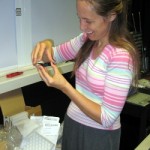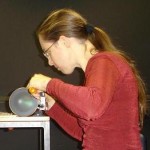This section of my website arose indirectly from my participation in the MP-scientist pairing scheme. I was asking my MP, Dave Anderson, what he was interested in getting out of his visit to my lab, in order to plan a schedule for him. He said he was mainly interested in understanding what a scientist would do all day — “I mean, not trying to be funny, but for all I know you just sit around waiting for a bright idea.” So I thought people might find it interesting if I tried to give an idea of how I actually spend my time. Here are a few examples of things I might do during a day. I wouldn’t actually get anything like all of these done in a single day! — some of them would take several hours just on their own.
- Read emails. I try and deal with everything as it arises, so I’ll email most people back straight away, but save the time-consuming things for later.
- Look at the progress of a simulation I set going on Friday. I quite often have long Matlab simulations to run, maybe calculating the activity in a large population of model neurons, so I’ll often set that going on a Friday so my computer can be working on it over the weekend. Then on Monday, I’ll see if it’s given the results I was expecting. I may need to tweak a few parameters and try again, or with luck, I’ll be satisfied with the results. I can then save the file, and run a different simulation overnight or next weekend.
- Take some psychophysics data. This is where I sit viewing the projection screen, looking at strange stimuli I’ve invented, and pressing mouse buttons to indicate some simple judgment what I see. A simple example would be a random-dot stereogram displaying a square in depth: I’d press the left button if I perceived the square as being in front of the screen, and the right button if I perceived it behind. In psychophysics I’m usually interested in what happens when your perceptions are unclear — so I spend most of my time feeling as if I’m just guessing! I typically do a few hundred button-presses, view the results, adjust some parameters and try again. You can’t do psychophysics too long, though, as it’s quite tiring on the eyes.
- I attend a meeting of the Research Committee. This time we are mainly discussing, again, the Research Assessment Exercise which will be carried out this autumn. We also discuss how to increase the application rate and success rate of grant applications made by members of the department.
- A paper I reviewed previously has been resubmitted, and the editor invites me to comment on the resubmission. I look up my original notes on the paper, and see that I was worried about a possible artefactual explanation for the results. I also didn’t agree with one of their equations. The authors have responded to this by citing other literature that suggests this artefact is not a concern. The reason I’d derived a different equation was that I hadn’t followed exactly what they had done. They’ve now explained it more clearly and I follow their derivation. I email the editor saying that I’m happy for the revised paper to be published.
- My PhD student comes in to see me with an idea for a new stimulus. Over a cup of tea, we argue through the pros and cons, possible artefacts, whether this would be an improvement or not on our current experiment.
- Try and catch up on the literature. A colleague drew my attention to a recently-published paper which sheds new light on an issue I’ve pondered, so I download it from PubMed, read it through and jot down some notes. I keep a record of everything I read in Endnote, a reference manager, so that I can look up later and see if I’ve read a particular paper and what I thought about it. A few key papers have several sets of my comments, separated by years — I find it interesting to see how my views evolve as my understanding matures. Sometimes, I regret to say, I come across a paper which I think is really interesting and will definitely need to bear in mind for my future work. I carefully add it to my Endnote list — and notice that I already have an entry for the exact same paper, complete with notes from when I first read it several years ago. The scarey thing is that I have just re-read it with no recollection of having seen it before. Sometimes, admittedly, this is because my own understanding of the subject has matured so much that I now extract a completely different message from the paper than when I first read it.
- I clear some pending work for the ethics committee. An undergraduate student has sent it an application form requesting ethical clearance for their project. The project follows the same format as dozens of others before it, she has plans in place for informed consent etc, and the work raises no particular ethical issues. I’m therefore able to issue approval immediately. Another application, submitted by a graduate student, is slightly different from anything I’ve seen before. I think it should be approved, but I forward this application to the other members of the ethics committee to ask their views. If they think it raises potentially serious ethical concerns, it will have to be sent on to the University Ethics Committee for their consideration.
- An email arrives from someone who’s been reading one of my papers and has some questions. He politely draws my attention to some apparent contradictions and says he can’t replicate the results in one of the figures (a computer simulation). Although I have several things to do which are more urgent, the thought that he might have found a mistake in my work won’t let me concentrate on anything else! It’s been 5 years since I wrote the paper, so I have to spend some time getting back into it. To my relief, I quickly find that the “contradictions” are based on a simple misunderstanding of the original paper. I write an explanation. The simulation problem is more severe. I dig back into my archives and extract the code. It gives the results I originally reported. The code isn’t that complicated, so I also rewrite it from scratch, and am reassured to find I still get the same results. I email this code to the reader; hopefully he will be able to figure out why he was getting different results. As a consequence of re-reading my paper in such detail, I have found three more errors (e.g., one figure claims to show a spatial frequency bandwidth of 1.5 octaves, but it’s really 2.5 octaves), as well as some minor errata I knew about before. It’s worrying to think that, despite all my efforts, presumably all my publications contain such errors. As I find mistakes, I publish them on my website, so at least subsequent readers will be alerted to them.
- Finish off with a few small admin tasks, e.g. claim for travel expenses, order a piece of kit for the lab.
- Working with an eyetracker – my PHD student Graeme Phillipson & me
- Setting up a mirror stereoscope





















